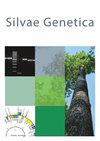墨西哥东部特有的两个木兰属物种的结构、多样性和基因划界
IF 1
4区 农林科学
Q3 FORESTRY
引用次数: 0
摘要
在墨西哥,Macrophylla 科的木兰属植物已根据表型特征进行了分类。然而,在墨西哥东部地区的整个分布区,环境差异很大,这可能是造成该部分分类群形态差异很大的主要原因。因此,有必要在遗传水平上开展研究,以确认这些物种的分类学特征。本研究利用简单序列重复标记对 Magnolia rzedowskiana 和 M. zotictla 种群的多样性和遗传结构进行了估计。通过比较叶绿体 DNA 的三个区域:trnH-psbA、ORF350 和 rpl32-trnL,我们评估了作为独立物种的分类划分是否与它们的遗传分化程度一致。DNA 取自这两个物种的四个种群,它们分布在伊达尔戈州、克雷塔罗州和圣路易斯波托西州。这些种群呈现出中等程度的遗传多样性(He = 0.52-0.60)、有限的基因流(Nm = 0.62)和较高的遗传分化(Fst = 0.288),这可能与其栖息地高度破碎化导致的低密度和较强的地理隔离有关。系统进化分析和遗传分化值表明,所分析的两个木兰种的每个种群都是一个独立的进化单元,因此必须重新考虑对三个 M. rzedowskiana 种群的分类划分。这些结果对于在短期内对这些种群实施管理和保护战略非常有用。本文章由计算机程序翻译,如有差异,请以英文原文为准。
Structure, diversity, and genetic delimitation of two Magnolia species endemic to eastern Mexico
In Mexico, Magnolia species of the section Macrophylla have been segregated based on phenotypic characteristics. However, the wide environmental variation throughout their distribution area in the eastern region of the country could be the main cause of the high degree of morphological variation among the taxa of this section. Therefore, it is necessary to carry out studies at the genetic level to confirm the taxonomic identity of these species. In the present study, the diversity and genetic structure of the populations of Magnolia rzedowskiana and M. zotictla were estimated using simple sequence repeat markers. We evaluated whether the taxonomic delimitation as independent species is consistent with their degree of genetic differentiation, comparing three regions of chloroplast DNA: trnH-psbA, ORF350, and rpl32-trnL. The DNA was obtained from four populations of the two species, which are distributed in the states of Hidalgo, Querétaro and San Luis Potosí. The populations presented intermediate–high genetic diversity (He = 0.52–0.60), limited gene flow (Nm = 0.62) and high genetic differentiation (Fst = 0.288), which may be related to their low density and strong geographic isolation, caused by the high degree of fragmentation of their habitat. The phylogenetic analysis and the genetic differentiation values indicate that each of the populations of the two Magnolia species analyzed behaves as an independent evolutionary unit, so the taxonomic delimitation of the three M. rzedowskiana populations must be reconsidered. The results obtained could be very useful for implementing management and conservation strategies for these populations in the short term.
求助全文
通过发布文献求助,成功后即可免费获取论文全文。
去求助
来源期刊

Silvae Genetica
农林科学-林学
CiteScore
2.20
自引率
10.00%
发文量
10
审稿时长
3 months
期刊介绍:
Silvae Genetica is an international peer reviewed journal with more than 65 year tradition and experience in all fields of theoretical and applied Forest Genetics and Tree breeding. It continues "Zeitschrift für Forstgenetik und Forstpflanzenzüchtung" (Journal of Forest Genetics and Forest Tree Breeding) founded by W. LANGNER in 1951.
 求助内容:
求助内容: 应助结果提醒方式:
应助结果提醒方式:


